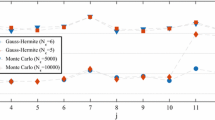Abstract
Euler-equation methods for solving nonlinear dynamic models involve parameterizing some policy functions. We argue that in the typical macroeconomic model with valuable leisure, labor function is particularly convenient for parameterizing. This is because under the labor-function parameterization, the intratemporal first-order condition admits a closed-form solution, while under other parameterizations, there should be a numerical solution. In the context of a simulation-based parameterized expectations algorithm, we find that using the labor-function parameterization instead of the standard consumption-function parameterization reduces computational time by more than a factor of 10.
Similar content being viewed by others
References
Bjorck, A. and Pereyra, V. (1970). Solution of Vandermonde systems of linear equations. Mathematics of Computation, 24, 893s–903.
Christiano, L. and Fisher, J. (2000), Algorithms for solving dynamic models with occasionally binding constraints. Journal of Economic Dynamics and Control, 24, 1,179–1,232.
Coleman, W. J. (1990). Solving the stochastic growth model by policy function iteration. Journal of Business and Economic Statistics, 8, 27–29.
Den Haan, W. and Marcet, A. (1990). Solving the stochastic growth model by parametrizing expectations. Journal of Business and Economic Statistics, 8, 31–34.
Maliar, L. and Maliar, S. (2001). Heterogeneity in capital and skills in a neoclassical stochastic growth model. Journal of Economic Dynamics and Control, 25, 1,367-1,397.
Maliar, L., and Maliar, S. (2003). Parameterized expectations algorithm and the moving bounds. Journal of Business and Economic Statistics, 21/1, 88–92.
Marcet, A., and Lorenzoni, G. (1999). The parameterized expectation approach: some practical issues. In R. Marimon and A. Scott (eds.), Computational Methods for Study of Dynamic Economies, 143–171, Oxford University Press, New York.
Rust, J. (1996). Numerical dynamic programming in economics. In H. Amman, D. Kendrick and J. Rust (eds.), Handbook of Computational Economics, 619–722, Elsevier Science, Amsterdam.
Author information
Authors and Affiliations
Additional information
JEL classification: C6, C63, C68
Rights and permissions
About this article
Cite this article
Maliar, L., Maliar, S. Parameterized Expectations Algorithm: How to Solve for Labor Easily. Comput Econ 25, 269–274 (2005). https://doi.org/10.1007/s10614-005-2224-9
Accepted:
Issue Date:
DOI: https://doi.org/10.1007/s10614-005-2224-9




